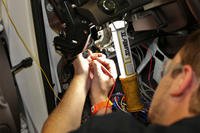by Kyle Francis
Jump Links
- A Disagreement With Enzo Ferrari Led To The Establishment Of Lamborghini
- Lamborghini Established The Supercar Category Within Just Two Years
- The Countach Continued The Miura's Legacy
- Lamborghini Achieved Its Quest In Style
These days, road vehicles hitting 200 mph barely registers within the minds of auto manufacturers or gearheads. It's almost expected that any high-performance car should top out around this mark, especially given the level of engine technology and aerodynamic understanding that has been gained over the last several decades. During the 20th century though, this figure held a mythical aura.
Everyone wanted to build the first production vehicle that could blow past the benchmark, but it took a long time to get there. The first to nail the brief was Lamborghini, and it took an impressively quick 27 years to go from nothing to offering the fastest production vehicle in the world.
A Disagreement With Enzo Ferrari Led To The Establishment Of Lamborghini

Lamborghini
Lamborghini's origins are firmly understated in nature, given that founder Ferruccio Lamborghini built a substantial part of his fortune by instead offering tractors for the farming industry. His endeavor made him a very rich man, as he was able to roll around in a Ferrari 250 GT. It wasn't exactly reliable though, and when Lamborghini complained about the car eating through clutches to the great Enzo himself, he was essentially told to get over it. Incensed by Ferrari's rudeness, Lamborghini instead decided to get his own back by founding his very own performance car company.
Lamborghini Came On The Scene In 1963

Lamborghini
Having established the new marque in 1963, its first car, the 350 GT, made its debut in 1964. Rather than the crazy supercars that the company later became known for, the 350 GT was more of an upmarket GT car. Its naturally aspirated 3.5-liter V12 engine was designed by talented engineer Giotto Bizzarrini, and the cabin was lavished with luxury fixtures and fittings. A total of 150 cars ended up being built, which went down well with customers.
The 400 GT was developed to replace it two years later, with its name being inspired by the enlarged 4.0-liter V12 powerplant slotted beneath the hood. It also differed from the 350 GT by having two rear seats, making it a 2+2 coupe. Before too long, Lamborghini started working to bury Ferrari from a performance perspective.
Lamborghini Established The Supercar Category Within Just Two Years

Lamborghini
Around the same time as the 400 GT coming on the scene, Lambo also revealed its first pure performance car. Named the Miura, Lamborghini pulled out all the stops to ensure that the machine would be the most commanding road vehicle on earth. For starters, its 4.0-liter V12 kicked out 345 hp to the rear wheels via a five-speed manual gearbox. The layout was unusual as it was laid out transversely in the center of the car. The mid-mounted location improved the weight balance of the vehicle, while being transversely-placed rather than the more traditional longitudinal layout meant the chassis could be made shorter. This had the advantage of ensuring the Miura would be more agile through the bends.
Read the full article on CarBuzz
This article originally appeared on CarBuzz and is republished here with permission.










